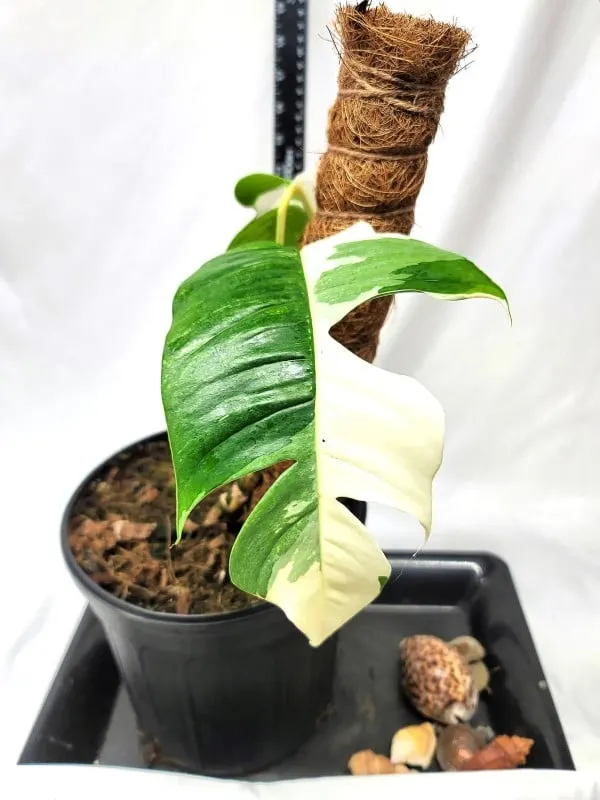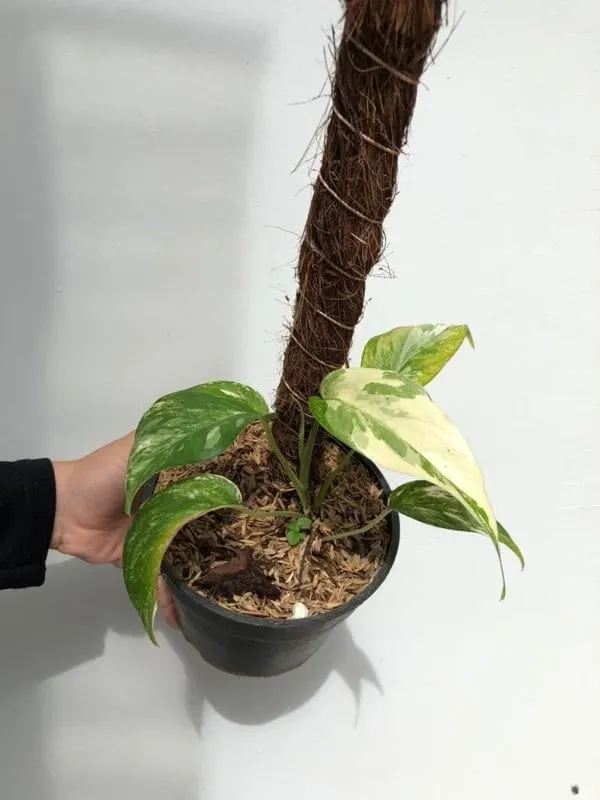Epipremnum Pinnatum Variegated is a hardy plant with trailing tendrils trained vertically even horizontally across walls. Its low maintenance make it a popular option in homes.
You will frequently see it falling off mantelpieces or down shelves. Like its species, it has a climbing habit, and in the wild, it attaches itself to trees to find more light in the rainforest. The plant itself is quite poisonous, though, so don’t add the leaves to your fruit salad.

Care tips forEpipremnum Pinnatum Variegated
1. Soil
The potting mix for growing Epipremnum Pinnatum Variegated can be purchased at a flower shop. The finished substrate in its composition contains all the necessary useful elements. It has been specially developed for the care of indoor plants.
The Epipremnum Pinnatum Variegated can be independently mixed with the necessary components and prepared at home. When planting or transplanting, do not forget to pour a drainage layer on the bottom of the pot. It usually takes up ¼ of the capacity.
2. Lighting
Epipremnum Pinnatum Variegated boasts on any lighting. The only thing that it will not bear is the direct sun. The degree of possible shading is determined by the desire to keep patterns.
With gradual adaptation, the Epipremnum Pinnatum Variegated will grow perfectly and look luxuriously in light lighting lights, in a pot, and even in the shade.
But at the same time, the worse lighting, the stronger the patterns are lost. To manifest the ways that cover almost all the leaves, you need the most bright lighting. For green-shaft species and varieties, even shadow is allowed.
3. Temperature
For the Epipremnum Pinnatum Variegated to develop normally and feel comfortable in any room space, it must maintain an acceptable temperature regime. Typically, room temperature should be between 16 and 27°C.
Note that Epipremnum Pinnatum Variegated does not tolerate even a light breath of wind or draft at all. For this reason, it is not recommended to decorate open-type loggias, balconies, or gazebos on an individual plot with this type of plant.
4. Watering
Although the Epipremnum Pinnatum Variegated naturally grows in tropical climates, it is considered a drought-resistant crop. Water, the plant as the topsoil layer, dries completely.
If you water it uncontrollably, the plant can get sick due to waterlogging of the soil. To check for excess moisture in a pot, you need to inspect the reverse side of the sheet plate. If there are droplets of water, the plant is overfilled with water. This is a very worrying sign.
5. Humidity
The optimum humidity for the Epipremnum Pinnatum Variegated is 60%, but fluctuations in the range of 40-80% for it pass without negative consequences. For this reason, it is perfectly acceptable to place a pot in the kitchen.
6. Top dressing
The best option would be to fertilize every three weeks. If it is a liquid substance for flower crops, taking exactly half, the dose is better. This is provided that Epipremnum Pinnatum Variegatedis on additional illumination even in winter.
If you decide to arrange rest for the loach, do not fertilize. In other cases, the top dressing should be applied according to the traditional scheme – from spring to late autumn.
7. Transfer
All the transplant work can be planned once every 2-3 years, but not more often. It is best to do this in the spring, at the moment when the flower culture awakens.
Do not forget to water the Epipremnum Pinnatum Variegated before the procedure. Trim some flower lovers plant two or three shoots in a container simultaneously.
Not all gardeners know exactly when a plant needs to be transplanted. It will be seen immediately: the root system will fill the entire capacity. But the next container should be only slightly larger than the old one.
Active growth will go on in the first months after transplantation, and after that, it will slow down. And it does not matter what material the pot is made of, and you can choose plastic, wood, ceramics.

Propagation methods
i. Propagation by layering
This technique for propagating Epipremnum Pinnatum Variegated consists of pinning and sprinkling one or more nodal shoots. It is sprinkled with soil mixture directly in a pot with an adult plant.
The main thing is to pin the wire well to the soil’s surface. If the Epipremnum Pinnatum Variegated aerial root takes root, then the stem part must be cut off, and a soil substrate added.
ii. Propagation by cuttings
To propagate Epipremnum Pinnatum Variegated by cuttings, small shoots are cut, on which there are 2-3 nodal leaves. Sections of cuttings are treated with growth stimulants dried a little. After that, they are installed in a prepared mixture consisting of a peat layer and coarse sand.
When rooting, maintain a temperature of + 22-25 °C in the room. At the same time, regular spraying is not neglected. A complete root system is formed within 2-3 weeks.
iii. Propagation by division
You can grow several Epipremnum Pinnatum Variegated from an elongated shoot at once. To do this, carefully cut off one shoot from the mother plant and divide it into several parts.
Each of them should have only a couple of leaves. A new shoot will grow from the axillary part is rooted in the finished substrate.
Diseases and Pests
Diseases arise due to errors in care: excess and stagnation of moisture, incorrect temperature, and lack or excess of lighting. The plant fades from this; the leaves dry, darken or turn yellow. To get rid of unpleasant manifestations, you need to eliminate errors in the content.
Epipremnum Pinnatum Variegated can be affected by aphids that feed by plant extract. Epipremnum Pinnatum Variegated is treated with soapy water and sprayed with infusion on the peel of citrus fruits to eliminate the insect. Use pesticides like Fitoverm, Trichopolum, and Fufanon.
Brown spots appear on the leaves. You can cope with the pathological condition with the help of pesticides from stores like Aktara and Actellik. Also, it can be attacked by the spider mite.
The plant begins to dry, and a thin web appears. It is recommended to rinse Epipremnum Pinnatum Variegated in the water.
Conclusion
Epipremnum Pinnatum Variegated is an important plant that is more colorful and vibrant. It is the right plant you should have in the house. It does not only enhance your home, but also it offers a better comfort level for a long period.
